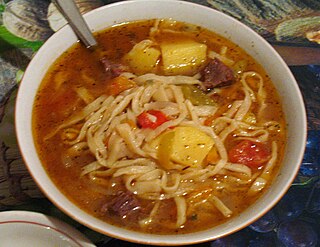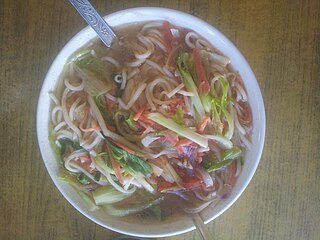
The Tibetan script is an abugida used to write the Tibetic languages such as Tibetan, as well as Dzongkha, Sikkimese, Ladakhi, and sometimes Balti. The printed form is called uchen script while the hand-written cursive form used in everyday writing is called umê script.

Momo is a type of South Asian dumpling, popular across the Indian subcontinent and the Himalayan regions of broader South Asia. Momos are native to Tibet, Bhutan, Nepal, North Indian region of Ladakh, Northeast Indian regions of Sikkim, Assam, and Arunachal Pradesh, and Darjeeling, West Bengal, India. It is similar to Chinese baozi and jiaozi, Mongolian buuz, Japanese gyoza and Korean mandu, but heavily influenced by cuisine of the Indian subcontinent with Indian spices and herbs.

Cuisine of the Indian subcontinent includes the cuisines from the Indian subcontinent comprising the traditional cuisines from Bangladesh, Bhutan, India, Nepal, Pakistan, Sri Lanka and the Maldives.

Noodle soup refers to a variety of soups with noodles and other ingredients served in a light broth. Noodle soup is common dish across East and Southeast Asia. Various types of noodles are used, such as rice noodles, wheat noodles and egg noodles.

Thukpa is a Tibetan noodle soup, which originated in the eastern part of Tibet. Amdo thukpa is a famous variant among Tibetan people and himalayan people of Nepal. The dish became popular in various parts of Nepal, Bhutan, and the states of Sikkim, Assam, Nagaland and Arunachal Pradesh in northeast India. It is also popular in the Ladakh region and the state of Himachal Pradesh. The food is widely available in these regions. The numerous varieties of thukpa in Tibetan tradition include:

Bhutanese cuisine employs a lot of red rice, buckwheat, and increasingly maize. Buckwheat is eaten mainly in Bumthang, maize in the Eastern districts, and rice elsewhere. The diet in the hills also includes chicken, yak meat, dried beef, pork, pork fat, and lamb. Soups and stews of meat, rice, ferns, lentils, and dried vegetables, spiced with chili peppers and cheese, are a favorite meal during the cold seasons. Zow shungo is a rice dish mixed with leftover vegetables. Ema datshi is a spicy dish made with large, green chili peppers in a cheesy sauce, which might be called the national dish for its ubiquity and the pride that Bhutanese have for it. Other foods include jasha maru, phaksha paa, thukpa, bathup, and fried rice. Cheese made from cow's milk called datshi is never eaten raw, but used to make sauces. Zoedoe is another type of cheese made in the Eastern districts, which is added to soups. Zoedoe is normally greenish in color and has a strong smell. Other types of cheese include Western types like Cheddar and Gouda. Western Cheese is made in the Swiss Cheese Factory in Bumthang or imported from India.

Liangfen, also spelled liang fen, is a Chinese dish consisting of starch jelly that is usually served cold, with a savory sauce, often in the summer. It is most popular in northern China, including Beijing, Gansu, and Shaanxi, but may also be found in Sichuan and Qinghai. In Tibet it is called laping and is a common street vendor food.

Kesme or erişte is a type of egg noodle found in various Turkic cuisines, including Kyrgyz and Kazakh cuisine. It is also found in Turkish cuisine and is called erişte in modern standard Turkish. The word itself is a nominalisation of the verb to cut or to slice, referring to the slicing of the dough involved in preparing the noodles. The term may refer to the noodles themselves, or the prepared dish made with them. Kesme is traditionally a homemade dish, and not often found at restaurants or cafés. In Turkey, kesme is known as "erişte", and eaten generally in winter. It is made from flour, egg, water, salt and milk. These ingredients are worked into a dough, which is rolled out, cut, and dried in the sun or an oven after dried for a day.

Yak butter/ "Dri Butter" འབྲི་མར། is butter made from the milk of the domesticated female yak known as Dri འབྲི།. It is a staple food item and trade item for herding communities in south Central Asia and the Tibetan Plateau. Many different political entities have communities of herders who produce and consume yak's dairy products including cheese and butter – for example, China, India, Mongolia, Nepal, and Tibet.

The culture of Kashmir refers to the culture and traditions of Kashmir, a region in northern India, northeast Pakistan and the Chinese Occupied territory of Aksai Chin.

Shabhaley, also known as sha phaley, is a Tibetan dish of bread stuffed with seasoned beef and cabbage, which is then fashioned into semi-circular or circular shapes and which according to regional variations is either deep fried or pan fried like pot stickers.
Shosha, also known as churul or churu, is a type of cheese in Tibetan cuisine. Tibetan cheese is a staple food and is often made from animals suited to the climate such as yak and goat. It is a pungent cheese compared with blue cheese. It is used to make beef dish. It is a soft cheese.

Laping is a spicy cold mung bean noodle dish in Tibetan cuisine. It is a street food. It can be eaten with red pepper chili, cilantro and green onion sauce. The noodles have a slippery texture and are served with a soy sauce gravy. It is traditionally a summer food. A tool is used to shape it. The laping derives from the Sichuan-style liangfen.

Thukpa bhatuk is a common Tibetan cuisine noodle soup that includes small bhasta noodles. This dish is a common soup made in the winter but is especially important for Tibetan New Year. On Nyi-Shu-Gu, the eve of Losar, the common Tibetan soup, Thukpa bhatuk is made with special ingredients to form Guthuk. Guthuk is then eaten on Losar to symbolise getting rid of negativities of the past year and invite positives into the new year.














